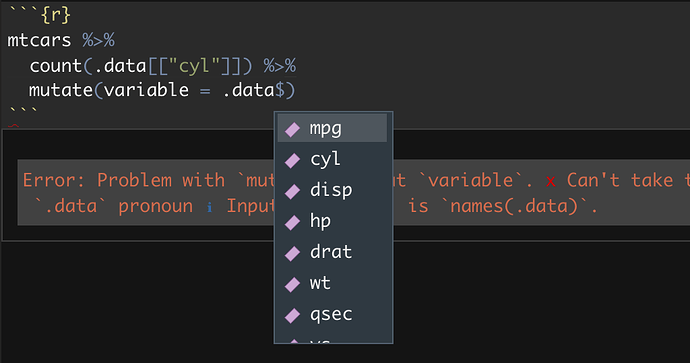I'm trying to develop a deeper understand of using the dot (".") with dplyr and using the .data pronoun with dplyr. The code I was writing that motivated this post, looked something like this:
cat_table <- tibble(
variable = vector("character"),
category = vector("numeric"),
n = vector("numeric")
)
for(i in c("cyl", "vs", "am")) {
cat_stats <- mtcars %>%
count(.data[[i]]) %>%
mutate(variable = names(.)[1]) %>%
rename(category = 1)
cat_table <- bind_rows(cat_table, cat_stats)
}
# A tibble: 7 x 3
variable category n
<chr> <dbl> <dbl>
1 cyl 4 11
2 cyl 6 7
3 cyl 8 14
4 vs 0 18
5 vs 1 14
6 am 0 19
7 am 1 13
The code does what I wanted it to do and isn’t really the focus of this question. I was just providing it for context.
I'm trying to develop a deeper understanding of why it does what I want it to do. And more specifically, why I can't use . and .data interchangeably. I've read the Programming with dplyr article, but I guess in my mind, both . and .data just mean "our result up to this point in the pipeline." But, it appears as though I'm oversimplifying my mental model of how they work because I get an error when I use .data inside of names() below:
mtcars %>%
count(.data[["cyl"]]) %>%
mutate(variable = names(.data)[1])
Error: Problem with `mutate()` input `variable`.
x Can't take the `names()` of the `.data` pronoun
ℹ Input `variable` is `names(.data)[1]`.
Run `rlang::last_error()` to see where the error occurred.
And I get an unexpected (to me) result when I use . inside of count():
mtcars %>%
count(.[["cyl"]]) %>%
mutate(variable = names(.)[1])
.[["cyl"]] n variable
1 4 11 .[["cyl"]]
2 6 7 .[["cyl"]]
3 8 14 .[["cyl"]]
I suspect it has something to do with, "Note that .data is not a data frame; it’s a special construct, a pronoun, that allows you to access the current variables either directly, with .data$x or indirectly with .data[[var]]. Don’t expect other functions to work with it," from the Programming with dplyr article. This tells me what .data isn't -- a data frame -- but, I'm still not sure what .data is and how it differs from ..
I tried figuring it out like this:
mtcars %>%
count(.data[["cyl"]]) %>%
mutate(variable = list(.data))
But, the result <S3: rlang_data_pronoun> doesn't mean anything to me that helps me understand. If anybody out there has a better grasp on this, I would appreciate a brief lesson. Thanks!
